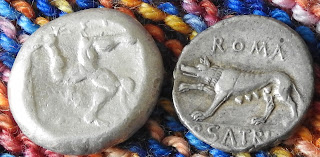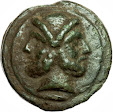Prow Left Cast
Sextans
Cr 36/5, 225 – 217 BC
I bought a prow left Sextans in the NAC auction last weekend. It is the 3rd prow left coin I have bought in less than a year, and the most expensive. I live in the US. The coin is across the Atlantic Ocean. I am sure it will take a while to get here, so I am using NAC's pictures.The largest issue of cast bronze coins by Republican Rome had the prow (business end) of a warship on the reverse. Most were prow right. I do not know why some prows were pointed left, but there were enough prow left coins that Haeberline put then into 3 groups. Crawford followed suite and had three groups also:
- First Prow Left cast coins, 225 - 217 BC, wt std As = 270 grams - Cr 36: 1 - As; 2 - Semis; 3 - Triens; 4 - Quadrans; 5 - Sextans
- Second Prow Left cast coins, 217 - 215 BC wt std As = 132 grams - Cr 38: 1 - As; 2 - Semis; 3 - Triens; 4 - Quadrans; there were struck Sextans, Uncia, Semuncia and Quartuncia coins in this group.
- Third Prow Left cast coins, 215 - 212 BC wt std As = between 132 and 54 grams - Cr 41: 1 - Decussis; 2 - Quincussis; 3 - Tressis; 4 - Dupondius; 5 - As; 6 - Semis; 7 - Triens; 8 - Quadrans; there were struck Semis, Triens, Quadrans, Sextans, Uncia and Semuncia coins in this group.
Roman Republic Cast Sextans circa 225-217, Æ
Obv - Head of Mercury l.; below, two pellets.
Rev - Prow l.; below, two pellets.
46.23 grams = 277 gram equivalent Ass
24 mm – this looks wrong, most on line are 30+
12 h – most of the cast coins I have seen are medal turn, or
the obverse and reverse have the same orientation. A few are orientated coin
turn, 6h. Even less have 3h or other orientations.
Brown green patina and very fine
Very rare (seller's words) – I found 10 examples on line, including mine.
Crawford 36/5, wt std = 270 grams
Aes Grave 23
Sydenham 82
Vecchi 92
Thurlow-Vecchi 62, wt std = 256 grams
RBW –.
Historia Numorum Italy 341.
Haeberlin p 55 – 56, plate 22, 17 – 20; wt range 34 – 54 grams













